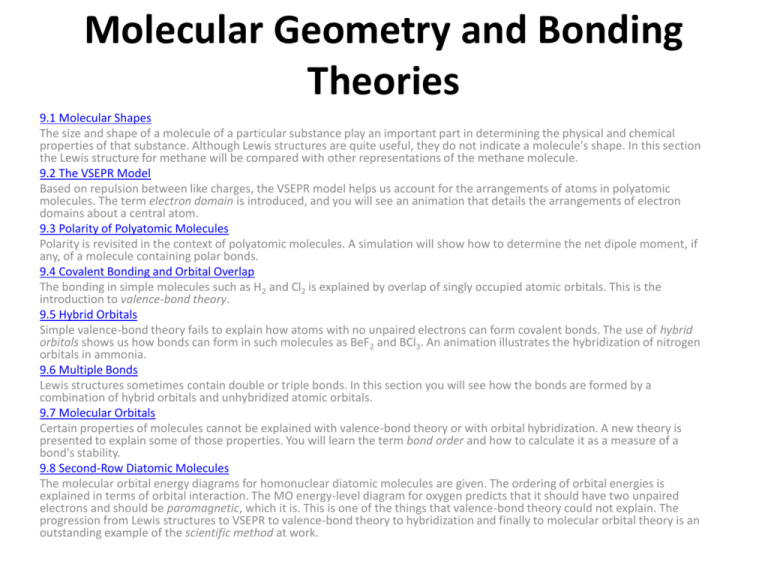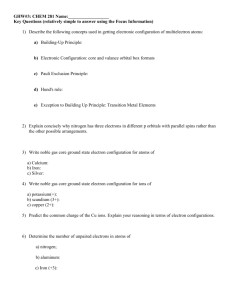Click to
advertisement

Molecular Geometry and Bonding Theories 9.1 Molecular Shapes The size and shape of a molecule of a particular substance play an important part in determining the physical and chemical properties of that substance. Although Lewis structures are quite useful, they do not indicate a molecule's shape. In this section the Lewis structure for methane will be compared with other representations of the methane molecule. 9.2 The VSEPR Model Based on repulsion between like charges, the VSEPR model helps us account for the arrangements of atoms in polyatomic molecules. The term electron domain is introduced, and you will see an animation that details the arrangements of electron domains about a central atom. 9.3 Polarity of Polyatomic Molecules Polarity is revisited in the context of polyatomic molecules. A simulation will show how to determine the net dipole moment, if any, of a molecule containing polar bonds. 9.4 Covalent Bonding and Orbital Overlap The bonding in simple molecules such as H2 and Cl2 is explained by overlap of singly occupied atomic orbitals. This is the introduction to valence-bond theory. 9.5 Hybrid Orbitals Simple valence-bond theory fails to explain how atoms with no unpaired electrons can form covalent bonds. The use of hybrid orbitals shows us how bonds can form in such molecules as BeF2 and BCl3. An animation illustrates the hybridization of nitrogen orbitals in ammonia. 9.6 Multiple Bonds Lewis structures sometimes contain double or triple bonds. In this section you will see how the bonds are formed by a combination of hybrid orbitals and unhybridized atomic orbitals. 9.7 Molecular Orbitals Certain properties of molecules cannot be explained with valence-bond theory or with orbital hybridization. A new theory is presented to explain some of those properties. You will learn the term bond order and how to calculate it as a measure of a bond's stability. 9.8 Second-Row Diatomic Molecules The molecular orbital energy diagrams for homonuclear diatomic molecules are given. The ordering of orbital energies is explained in terms of orbital interaction. The MO energy-level diagram for oxygen predicts that it should have two unpaired electrons and should be paramagnetic, which it is. This is one of the things that valence-bond theory could not explain. The progression from Lewis structures to VSEPR to valence-bond theory to hybridization and finally to molecular orbital theory is an outstanding example of the scientific method at work. Molecular Shapes • Valence-shell electron-pair repulsion (VSEPR) model • The molecular geometry of a molecule (or ion) refers to the arrangement of the atoms. • The term electron domain refers to a lone pair or a bond—whether that bond is single, double, or triple Polarity of Polyatomic Molecules The bond dipole is the dipole moment due only to the two atoms bonded together. The bond dipoles are equal in magnitude, yet exactly opposite one another, and they cancel each other out. The overall dipole moment is zero. Covalent Bonding and Orbital Overlap • In valence-bond theory we envision atomic orbitals overlapping as atoms approach one another, which corresponds nicely to the VSEPR model. The region of orbital overlap provides the space in which bonding electron pairs reside. Hybrid Orbitals Multiple Bonds • The single bonds are called sigma (σ) bonds. In a bond the shared electron density lies directly along the axis between the two bonded nuclei (called the internuclear axis). A double bond actually consists of a s bond and a bond. A pi (π) bond is a covalent bond in which the overlap regions lie above and below the internuclear axis. Unlike a bond, in a bond there is no probability of finding the electron on the internuclear axis; in other words, the electron density does not lie directly between the atoms. Single Bond Pi bond (double bond) Triple Bond Molecular Orbitals • Some aspects of bonding are better explained by another model called the molecular orbital theory. • Atomic orbitals overlap to form molecular orbitals. When two atomic orbitals of equal energy overlap, they produce two molecular orbitals. Molecular Orbitals (continued) • A measure of the strength (and stability) of a bond in a diatomic molecule is the bond order. Bond order is determined by Second-Row Diatomic Molecules • The number of MOs formed equals the number of atomic orbitals combined. • Atomic orbitals combine most effectively with other atomic orbitals of similar energy. • The effectiveness with which two atomic orbitals combine is proportional to their overlap with one another; that is, as the overlap increases, the bonding MO is lowered in energy and the antibonding MO is raised in energy. • Each molecular orbital can accommodate, at most, two electrons, with their spins paired (Pauli exclusion principle). • When MOs have the same energy, one electron enters each orbital (with the same spin) before spin pairing occurs (Hund's rule). Unpaired electrons cause a molecule to be attracted to a magnetic field, paramagnetism. Molecules without unpaired electrons are weakly repelled from a magnetic field, and this type of magnetic behavior is called diamagnetism.






